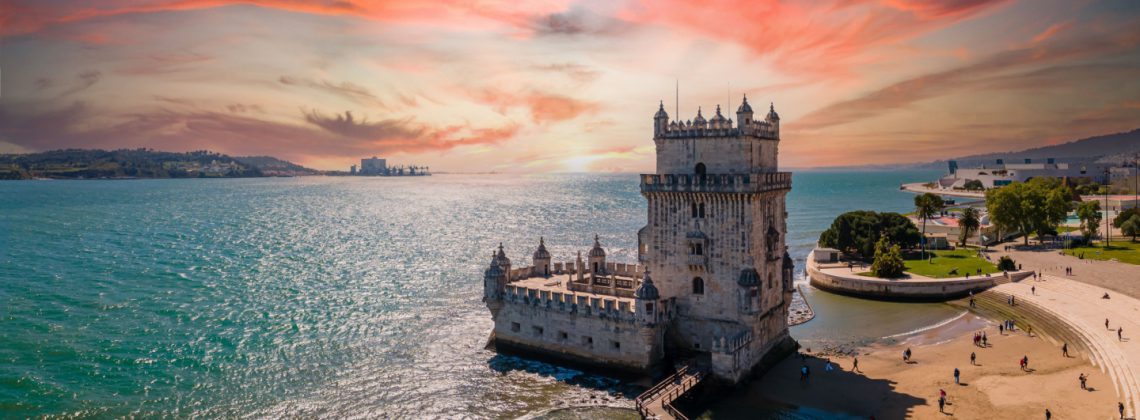Lisbon is the sunniest capital in Europe, enjoying over 300 days of sunshine per year. She is old, the second oldest capital in Europe. The Rio Tejo runs through her like a blue ribbon glistening in the southern European sun. Yet she is vibrant, bustling, and in many respects modern. With so much to see and do, it’s hard to know where to spend your time. I’ve been leading tours in Lisbon now for close to a decade, so let me guide you through a few of my top things to do in Lisbon.
Pro Tip: Planning a trip to Portugal? Organizing your trip is easier when you have all your resources in one place. Bookmark this post along with our Portugal guide for more planning resources. Also, check out our Best Places to Stay in Lisbon and Top Things to Do in Sintra, or if you fancy a beach holiday but still get the glory of Lisbon, then check out our Where to Stay in Cascais article.
The Best Things To Do and See in Lisbon
The American art critic Mary McCarthy once said, “Any Portuguese town looks like bride’s finery – something old, something new, something borrowed, and something blue.” It is hard to find a better description of Lisbon.
She is old, the second oldest capital in Europe. The Rio Tejo runs through her like a blue ribbon glistening in the southern European sun. Yet she is vibrant, bustling, and in many respects modern.
She is the sunniest capital in Europe, with over 300 days of sunshine per year. The winters are mild but can get wet. When wet, her glistening pavements and vertiginous hills have taken down many an unprepared tourist. So bring a rain jacket and good walking shoes. Best to bring your stretchy trousers as well, as Lisbon is a gastronomical delight.
The most important thing to remember here is to slow down. Lisbon may be a capital city, but nothing here is in a hurry. Don’t expect your receipt the moment you finish lunch. You’ll likely need to ask two or three times. So sit back, enjoy another glass of vinho verde, and enjoy the show.
Is this list exhaustive? Of course not, it is purely opinion. I’m creeping up on forty and have no interest in the hipsterfication of Lisbon and the arrival of the avocado as some kind of wonder food. I’m not always up to date with all the newest bar openings or the best nightclubs, but if you want history, good traditional Portuguese food, and some great bars, then there should be something on this list for you.
Not ready to book a tour? Check out our Where to Stay in Lisbon
Oh salty sea, how much of your salt is tears from Portugal?
Fernando Pessoa
1. Save your legs– take a Tuk Tuk Tour

Lisbon’s serpentine streets are best explored with a local, but a day of walking around hills sounds less than glamorous. The only option is a tuk‑tuk tours turn that into an effortless joyride.
Picture gliding up and down the city’s famous seven hills without huffing or puffing, all while a passionate guide unfolds Lisbon’s story. Whether you choose the 2‑hour private route rocketing through Rossio, Alfama, Commerce Square and the best miradouros, the 3‑hour “Ultimate” experience through Baixa, Graça, Alfama and Chiado, or the 4‑hour food‑and‑sight tour that pairs bifana sandwiches, croquettes, pastel de nata, green wine, and cherry liqueur with stops in Baixa, Alfama, and Mouraria, every option delivers the best of Lisbon’s charm.
Glide, taste, learn, and let Lisbon pour its soul into you, all without breaking a sweat.
2. Explore the Soul of Lisbon in Alfama
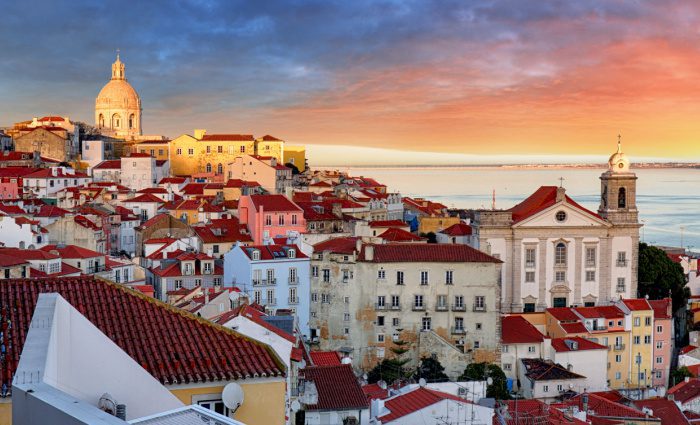
For years I have told tourists the importance of taking a local guide around the streets of Alfama—someone to show you its history, to share its culture. This old fisherman’s quarter holds many charms, and its warren of streets can sometimes hide them.
Then again, there is something delightful about simply getting lost in Lisbon’s oldest neighborhood. Its vertiginous streets twist and turn like a serpent, running from its peak at the Castelo São Jorge and running all the way down to the glistening blue Rio Tejo below.
The joy is in the journey, not the destination!
Alfama (from the Arabic al-hamma, meaning thermal springs) shows signs of occupation from the Iron Age onwards, with evidence of habitation under the Romans, Visigoths, and Moors before the founding of Portugal in the 12th Century.
It was one of the only neighborhoods to survive the great earthquake of 1755 and still holds its Moorish and medieval charm. No inch of Alfama is uniform. When you think you have your bearings, a road splits in two, turns you eighty degrees, and you are lost again.
That is its beauty! Take a stroll for long enough, and you’ll stumble upon a Roman Theatre, the Castelo São Jorge, the Sé de Lisboa (the cathedral), a cat napping in the mid-day sun, a fishwife selling Ginjinha (the local firewater), a miradouro or two (beautiful terraced viewpoints), sweet pastel courtyards, a fado house or twenty and everything in between.
The only rule of Alfama? When the huge tour group goes left, you go right! Choose your own adventure.
3. Breach the Walls of Castelo São Jorge
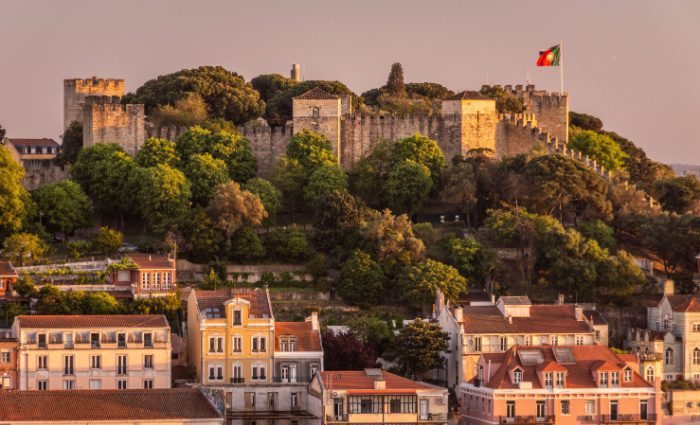
The Castelo de São Jorge is Lisbon’s most visited attraction and for a good reason. Sat perched on top of Lisbon’s highest hill, its sturdy walls and toothy crenelations have witnessed considerable changes in Lisbon’s history.
Built on top of an Iron-Age settlement, the Romans were almost undoubtedly the first to fortify the area. However, the castle we see today is far more likely to be Moorish in its origin, dating to the 8th Century AD. King Afonso Henrique captured the fort after the siege of Lisbon on October 25th, 1147.
The castle and its commanding presence became a bolthole for the monarchy, and it was the residence of the royal court until Manuel I’s decision to move the palace closer to the waterfront in 1505.
The castle, stripped of its royal prestige, became a military barrack until the 20th Century. From the 1940s onwards, the castle was reopened to the public and became a place of leisure. The state planted indigenous trees like Stone Pines, Mediterranean Cypruses, and foreign Jacarandas in abundance.
Today Castelo de São Jorge is one of the most enjoyable spots in the summer months. The shade of the trees and the sea breeze make it a pleasant spot. With plenty of cafes, it’s incredibly popular come sunset. On the other hand, my daughter loves nothing more than buying birdseed from the gift shop and feeding the forty peacocks that call the castle home.
Something for everyone, indeed!
Location: Castelo Sao Jorge
Opening Hours: Daily, Nov-Feb 9 am – 6 pm, Mar-Oct 9 am – 9 pm
4. See the Spoils of Exploration at The Monastery of Jerónimos
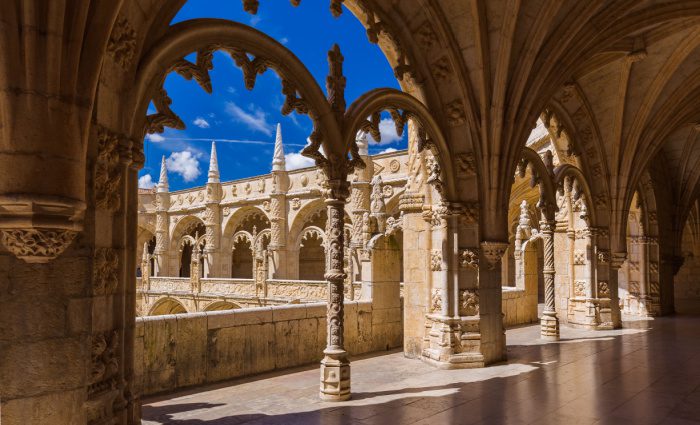
In 1495 the newly crowned king Manuel I requested permission from the Pope to found a hermitage to the Brotherhood of St. Jerome over the old Church of Santa Maria da Belém (Mary of Bethlehem).
In that small church, Vasco da Gama prayed and sat vigil on the eve of his departure to India in 1497. When he returned, the world had changed. A new age of globalization had begun.
The foundation stones for the new monastery were laid in 1501, with construction paid for with a 5% tax on all goods arriving from India. The wealth from that venture was so great that in 1514 the king abandoned the original plans, and a new, grander venue was envisioned.
It remains the most remarkable example of Portuguese Manueline architecture, a style unique to Portugal and its colonies. Today the visitor will be wowed by the plateresque architecture of the main cloister as well as being able to visit the tombs of Manuel I and his dynasty and the tomb of Vasco da Gama, who was moved from Goa and reburied in the monastery in 1894.
Location: Monastery of Jerome
Opening Hours: Daily 9.30 am – 6 pm (last entry at 5.30 pm)
5. Defend the River at the Tower of Belém
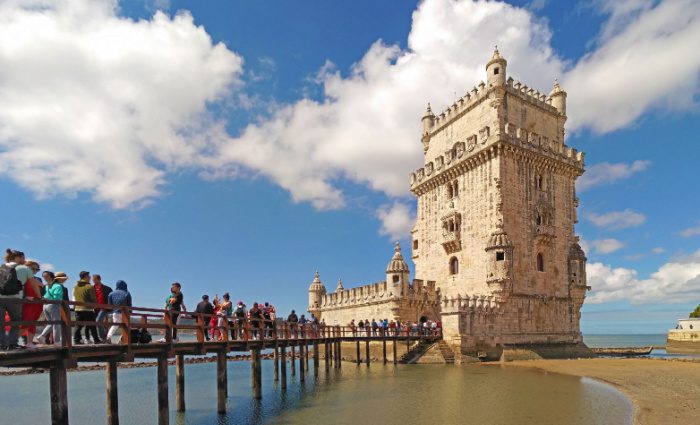
Lisbon has always been a target for raids. A Viking raid of twenty-eight ships was recorded during the Moorish occupation. Corsair and Pirate attacks were also common. So it comes as no surprise that with the massive accumulation of wealth that came with the Age of Exploration, so too came the need to defend that wealth.
That is where the Tower of Belém comes in. Architecturally the same Manueline style as the Monastery of Jerónimos, the tower was constructed in 1515-17. It was designed to protect the narrowest stretch of the Rio Tejo and the riches held within the monastery.
Today it still stands as a beautiful reminder of that Age of Exploration, but it was useless defensively. Attacked by the Spanish in 1580, it surrendered in under four hours. Portugal would remain a Spanish territory for the next sixty years.
Today the tower is a popular destination. You can walk the bulwark and climb the tower to see beautiful views over the Tejo. You can buy tickets in advance, but entry is limited to keep crowds small, and the lines are slow. Best to enjoy it from the outside or visit late in the day when the crowds have dispersed.
Location: Tower of Belém
Opening Hours: Tue-Sun 10 am – 5.30 pm (last entry at 5 pm)
6. Cruise the Tejo at Sunset
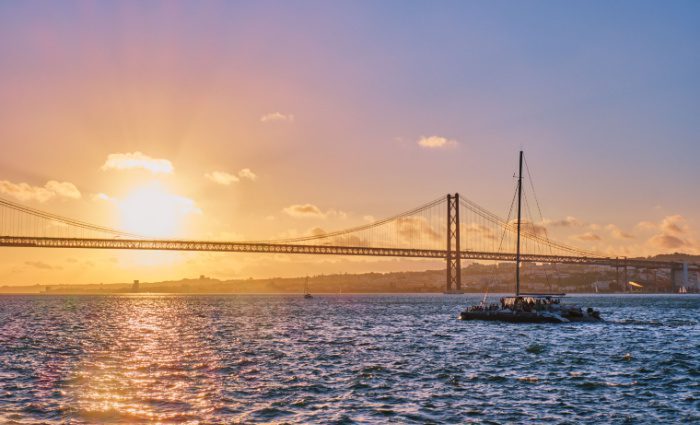
After living in Rome for ten years, my wife and I were looking for a new adventure. There were so many reasons we chose Lisbon, but for me, it was the Tejo. I just fell in love with it. The changing colors through the year, or even the day. Straw-like in the winter and aquamarine in the summer. It still gives me a little thrill every time a street opens up and I see a small postage stamp of its blue waters.
I can’t tell you how many sunsets I sat and watched with a cold glass of wine. Nor can I tell you how many strolls I’ve taken along the riverfront, how many miles I’ve cycled along it, how many meals with friends or family or nights spent enraptured by its seemingly timeless tides. But I can tell you how many times I’ve sailed on the river. Twice, once with my daughter when we were accompanied by a huge pod of dolphins who frequently venture into the estuary. The other with my wife, on our anniversary. We drank terrible prosecco and watched the sun disappear as we bobbed on our private yacht. Unforgettable!
7. Get Crafty at Quimera
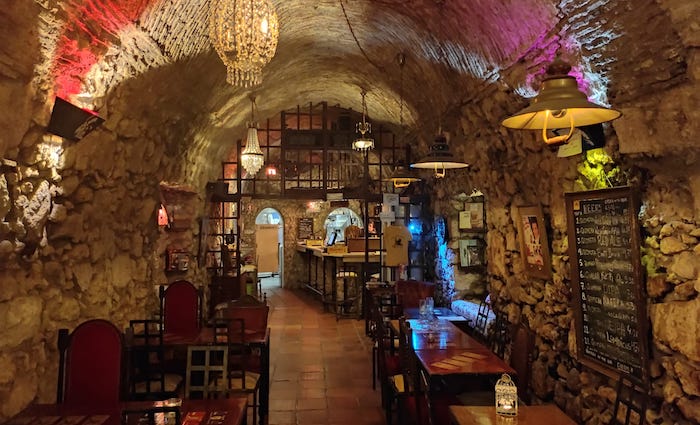
OK, an honest moment here. I was torn in two about including Quimera on this list. On the one hand, it’s magnificent. On the other hand, it’s my local, and I want to avoid fighting to get to the bar on a Friday night.
Founded in 2016 by Adam and Raquel, Quimera has quickly become a Mecca for the beer aficionados of Lisbon. It has been a labor of love.
Raquel scoured the country’s antique markets in search of the perfect chandeliers and decor to match the majestic 18th Century royal carriage tunnel where the bar is located. You’ll find Raquel behind the bar most evenings in her role as host.
Master brewer Adam brews around 12,000 liters a year (a rapidly increasing number). Every batch is distinctive, so no two barrels are the same. From sours to stouts, there is something for every palate on an ever-evolving board of beers. And that sounds like a good reason to keep coming back over and over again.
Location: Quimera Brewpub
Opening Hours: Weds – Sunday 5 pm – 11 pm
8. Savour Some Sardines

Sardines are a national obsession. They are everywhere in Lisbon, whether canned, grilled, sundried, or decorative. But undoubtedly, when it comes to the sardine, grilled is king.
Now when it comes to grilled sardines, there is a straightforward rule; we only eat them in a month without ‘R.’ So that is May, June, July, and August. You’ll find them on menus of tourist restaurants the rest of the year, but these will be frozen rather than fresh; trust me, you can tell the difference.
Lisbon celebrates the Santos Populares (the Popular Saints) throughout June, culminating with the feast of Lisbon’s own St. Anthony on June 13th. These month-long celebrations spill out onto the street, and the sound of Pimba Portuguesa (popular local music) and the sweet scent of grilled sardines fill the air.
Thirty-four million sardines are consumed in Lisbon alone during June, around sixty sardines per person. Challenge accepted!
If you are out of season, don’t worry, the Portuguese turn canned fish into an art form. Head to Conserveira de Lisboa for some tins to take home, or head to Sol e Pesca, an old fishing tackle shop, for beers and tinned sardines. Delicious!
9. Crustacean Station
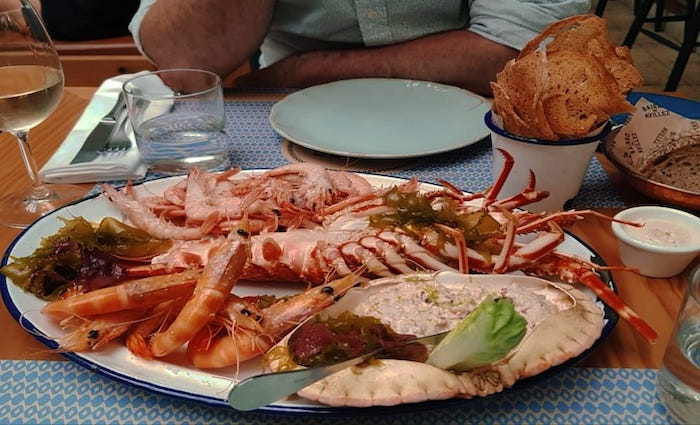
My god, the seafood in this city! It’s fresh and, most of the time, simple. Let the ingredients speak for themselves. From Algarve prawns to Atlantic percebes (Goose-kneck barnacles), there is such a variety, and some of it can seem a little odd if you are a foreigner and are not sure what each of these wonderful crustaceans is. What is the best way to find out? Dive in!
There are a few options. One, read our guide to the food of Portugal (coming soon), two, book a food tour (we have plenty of options) or three, head out on your own. You’ll generally want to look for a marisqueira (seafood hall) or a cervejaria (beer hall, but usually specializing in seafood).
My favorite spot is still Cervejaria Ramiro. It’s in every guidebook, every documentary, and on every tourist radar, but the quality hasn’t dipped, it’s still the undisputed king in Lisbon.
10. Explore Baixa
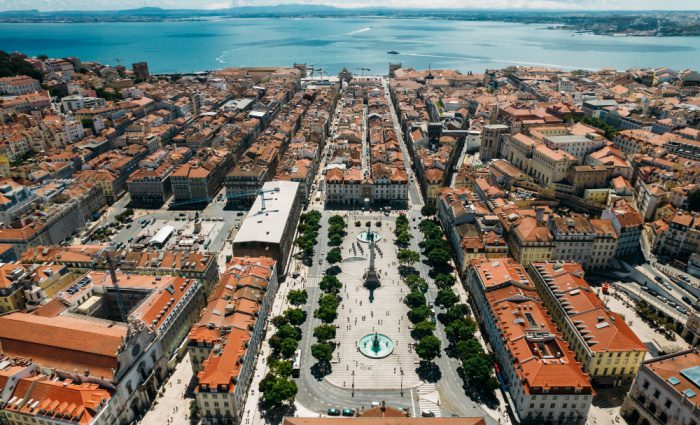
On November 1st, 1755, just before 10 am, Lisbon was hit by one of the largest earthquakes in European history. Modern seismologists believe it to have been somewhere between 8 and 8.5 on the Richter scale. If the earthquake wasn’t bad enough, the city was hit by a series of tsunamis that completely leveled the lower part of the city.
Although the soon-to-be Prime Minister, the Marquis do Pombal, would drive the city’s rebuilding, the military engineer Manuel de Maia and Eugénio dos Santos would design the new city.
If Alfama is a labyrinth of twists and turns, Baixa is orderly and uniform. The streets are laid out in a grid pattern, with three A-roads and eighteen B-roads. Dos Santos built every structure identically—the same square footage, height, windows, and doors on each one.
Historically this area is significant. However, I find it vanilla and incredibly touristy. I’m not particularly eager to eat down here; unless I’m giving a tour, I avoid it entirely. The same shops and brands in any European city have replaced anything quirky or unique.
Though sites like the Praça do Comércio and the Arco da Rua August mean you should at least pass through the area.
11. Watch the World go by at Praça do Comércio
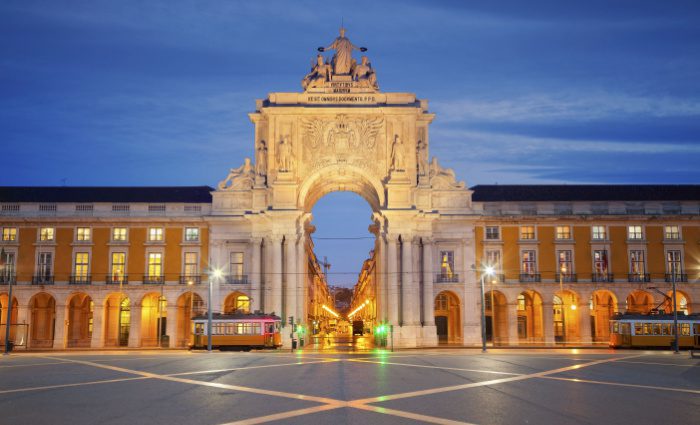
in 1505, Manuel I moved the Royal Court from the Castelo de São Jorge down to the riverfront. A far better location to watch the goods from India filter into Lisbon (no wonder he was nicknamed the grocer king). The square today known as Praça do Comércio was once referred to as the Terreiro do Paço (the Royal Terrace). That palace and terrace were destroyed by the earthquake of 1755.
Pombal, in his efforts to rebuild the city, wanted the nobility out. Old money is tied up in land, and what the city needed was an injection of ready cash. By moving the nobility out, he allowed a new middle-class of merchants to take over the city and reinvigorate its growth. And so, the royal terrace was replaced by the commercial square.
A statue of King José I sits in the middle, but the visitor’s eye will be drawn to the triumphal arch. Celebrating the Portuguese spirit and ability to rebuild after the earthquake. Victory stands at the top, crowning the virtues of Genius and Valour. Below are four heroes of Portuguese history; Viriato, Nuno Álverez Pereira, Vasco da Gama, and the Marquês do Pombal.
12. See the Earthquake As Devastation at the Carmo
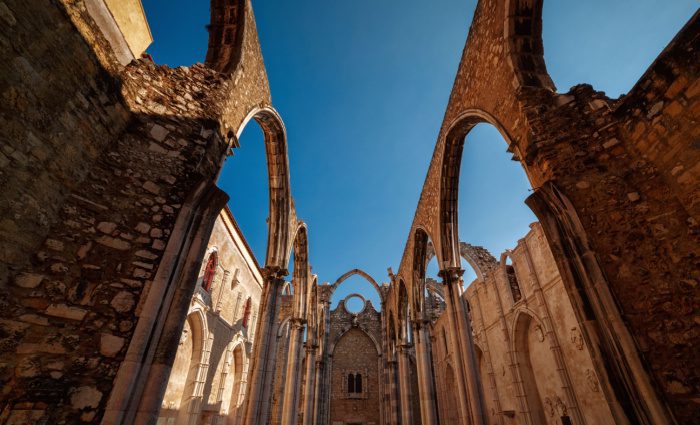
The Carmo is one of Lisbon’s most emblematic ruins and a daily reminder of the devastation caused by the earthquake of 1755.
Nuno Álvares Pereira (1360-1431) commissioned the church after defeating the Spanish at the battle of Aljubarrota in 1385. He laid down his sword and joined the convent of the Carmelites, donating his residence and wealth to build this magnificent monument.
Today the Carmo is little more than a skeleton. As one enters, you’ll see the vaulted ribs still standing, but the ceiling is no more. The aisles are no longer paved in marble, instead, a beautiful lawn, and the sacristy is no longer used to prepare holy rituals but rather a section of the archaeological museum.
Entry is €5, or you can instead head down to Topo, a bar that sits in its shade and charges around €4 for a glass of wine. Drink up while you soak up the view.
Location: Carmo
Opening Hours: Mon-Sat 9 am
13. Listen to Some Fado

For those wanting a bit of culture, why not try a Fado house? Protected by UNESCO as an ‘Intangible Cultural Heritage of Humanity,’ Fado is a form of hauntingly soulful folk music indigenous to Portugal. As permanent as the paved calçada beneath your feet.
Its most famous protagonist Amelia Rodrigues said, “The only thing that matters is to feel the Fado. The Fado is not meant to be sung; it simply happens. You feel it, you don’t understand it, and you don’t explain it.”
There are many Fado houses in Lisbon. Many are tourist traps. For the purest form, try Tasca do Chico. There is no entry fee. Just buy some drinks and snacks. Silence is expected when the Fadista performs, accompanied by Portuguese guitar. These performers are amateur, but their feelings are real, and many famous stars have blessed this storied venue. Just be sure not to be the first to applaud. The sudden snap of a clap breaks the spell, and applause is usually held for the end of the set and not at each song.
14. See the Sé
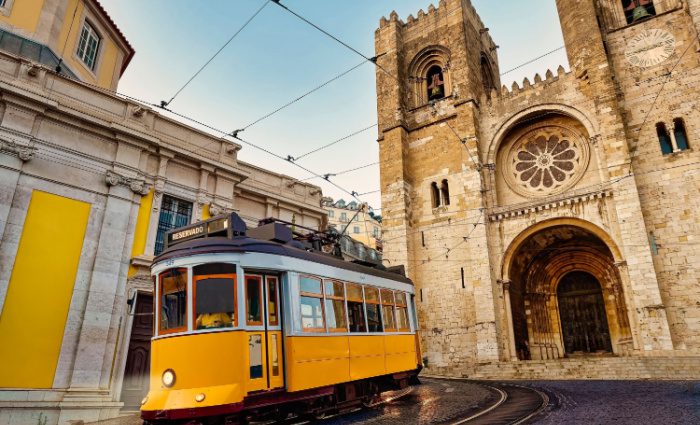
Do you know how a dog marks its territory? Well, the history of the Sé (the Cathedral of Lisbon) is very similar.
Archaeological evidence shows an early Pagan shrine was built over by the Romans. When Lisbon became Christian, a Visigoth church was built here. On their arrival, the Moors constructed a mosque. The Christian armies destroyed the mosque after the siege of Lisbon in 1147, and the church we see today was formed.
The earthquake of 1755 badly damaged the structure, and restoration in a concentrated way only began in the 1930s. Today the visitor sees a bare church with most Romanesque ornamentation gone, but with a long history and a fantastic archaeological nucleus at the back, it’s well worth a visit.
15. Experience Life’s Ups and Downs on the Elevador Santa Justa
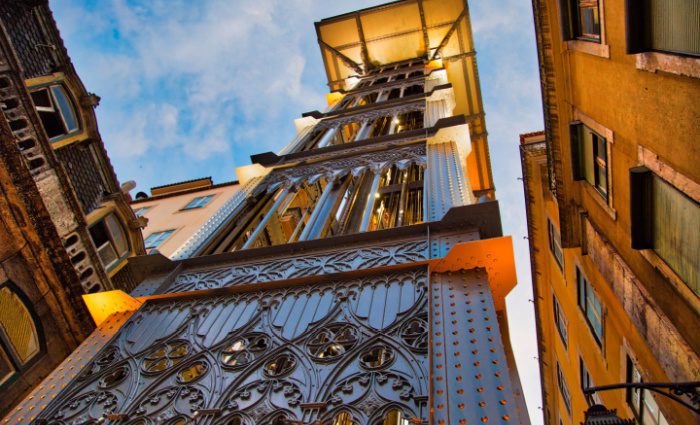
Lisbon is hilly! Built upon seven hills, you go uphill wherever you go in Lisbon—and coming back from the same place? Somehow that will be uphill as well.
So with all these ups and downs, it’s no surprise that in the late 19th and early 20th century, Lisbon introduced a series of electric trams, funiculars, and elevators.
The yellow trams buzzing around the city are beautiful, but nothing comes close to the Elevador de Santa Justa.
Often referred to as Eiffel’s elevator, it shouldn’t be. Although architecturally, it resembles the wrought iron architecture of the Eiffel Tower, Raoul Mesnier de Ponsard constructed it. Although a famous story exists that Ponsard studied under Eiffel, there is no evidence to support this.
You can spend an hour in line and pay €8 to ride to the top. Or you can walk to the top through Largo do Carmo for free, a far better option.
Location: Santa Justa
16. Take a Tram, But Not The #28
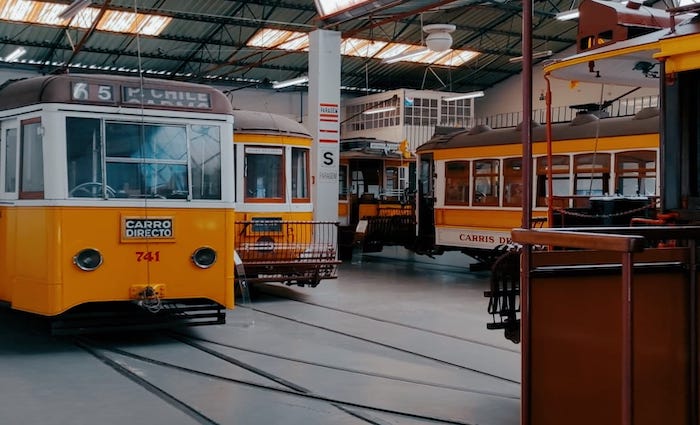
Look, I get it; those quaint yellow trams are on every bit of literature for Lisbon. Pictures of them feature in this article around four times alone. But its public transport and tourists piling on make it a nightmare for locals to use. So if you must, make sure you use it off-peak.
There is a tourist tram, it’s exactly the same model as the yellow ones, except it’s painted red. But do you know what you can’t tell when you are riding around on it? That it is red. The yellow trams cost €3 per ride and come with the added risk of highly-skilled pickpockets. The red tourist trams run on a 24-hour hop-off-hop-on system, far more civilized, and at €20 a day, you’re less likely to be troubled by pickpockets.
But my favorite alternative is to head to the Carris Tram Museum. My five-year-old daughter loves it here. The first part of the museum is a general history of the trams, but then you jump on a private historic tram that transports you to the old tram garage, where you can climb onto trams from all of Lisbon’s history. Kids love it, for adults, it is quiet and a safe space for kids to be kids, and you don’t have to find out what it’s like to be a tinned sardine. And did I mention its a bargain at just €4.50 for adults and kids under six go free.
Location: Carris Musuem
17. See Some Bosch Paintings

Another one of our family favorites. The Gulbenkian probably has the better collection, but it also has the crowds. I’ve spent hours wandering the corridors of the MNAA (Museo Nacional Arte Antiga). There are a few early Raphaels, some wonderful Dutch masters, and fantastic collections of Oriental art. But for me, the star of the show is Hieronymus Bosch’s wonderful triptych, depicting the temptation of St Anthony. Worth the €6 entry fee on its own.
Afterward, take a glass of wine in the gardens overlooking the river, not a bad way to spend an afternoon.
Location: MNAA
18. Devour Some Pastéis de Nata

The singular is pastel da nata, but you’ll never be able to eat just one, so you may as well learn the plural, pastéis de nata. These beautiful little egg custards in hand-rolled flakey pastry cases are delicious and addictive.
They are sold in most coffee shops around the city, and quality can vary greatly. For me, they taste best when fresh, so I prefer shops that specialize in the pastel da nata. In the city, it’s hard to beat Manteigaria. But for the original taste, head to Pastéis de Belem. Personally, I prefer the custard of Manteigaria but the pastry of Belém, but to figure it out yourself, you’ll just have to try both.
Just don’t take a photo of you holding it up in front of a famous monument. It’s been done to death, and it’s cliched, just eat the damn thing!
19. Drink Some Delectable Ginjinha
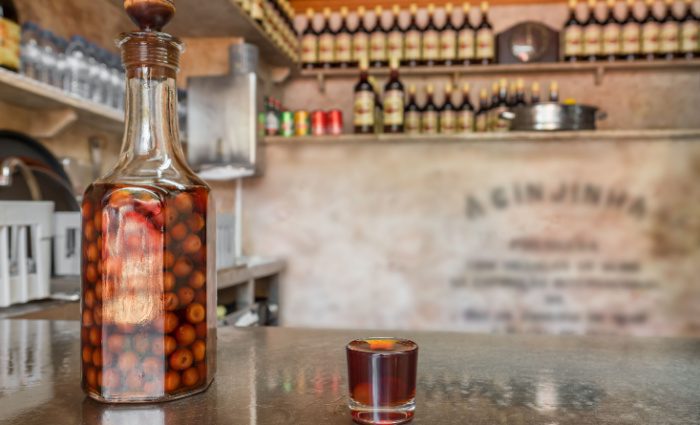
Every region of Portugal has its own ‘fire water’, in its pure form, it’s undrinkable. High in alcohol, low in taste, and burns as it goes down. So every region has a way of making it more palatable. In Lisbon, we add sour cherries, sugar, and cinnamon, the result? Ginjinha!
A Ginjinha in Largo São Domingos has been serving up ginjinha since 1840, and it’s still one of the best in the city, but for me, it stays firmly in second. The best? Ginjinha Sem Rival! The good news is the two stores are situated across from each other, so you can easily try both.
20. Stay Up Late
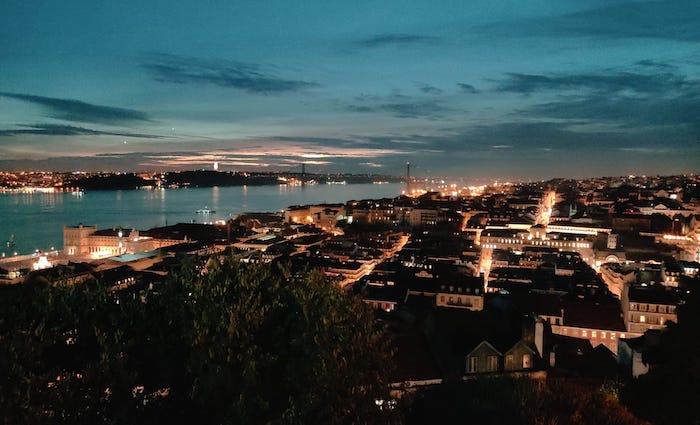
If you plan on enjoying a night out in Lisbon, be prepared to stay up late. Most people don’t sit down to eat till around 9 pm, and if you are planning on hitting the clubs, don’t bother heading out till midnight.
If that’s too late, don’t worry, Lisbon is a beautiful and safe city, so if you want to enjoy an early evening drink and stroll afterward, it’s a wonderful city to do so.
21. Get Up Early
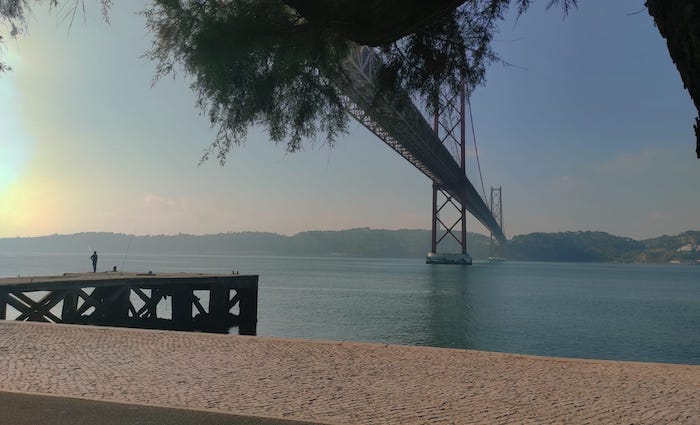
I hate exercising. But as I get older, the need seems to increase to keep the stomach from enlarging any further. The good news is that Lisbon, and especially the riverfront, is just beautiful in the morning. With the heat of the day yet to build, I love to take a cycle and jog along the waterfront before the crowd and the heat builds.
I suggest at least once during your stay in Lisbon that you get up with the fisherman and take a stroll along the riverfront. The area from Cais do Sodre right the way to Belém is fully pedestrianized and littered with electric bikes that you can easily pick up with your Uber app should the walk be a little too slow-paced for you.
Best Day Trips From Lisbon
22. Sumptuous Sintra
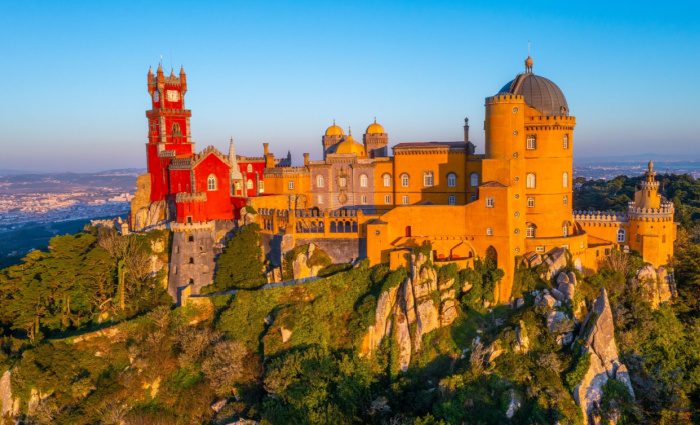
Just a 40-minute train ride from Lisbon, you will find yourself in one of Europe’s most beautiful locations, Sintra, or as Lord Byron declared it, “Glorious Eden.’ Sintra has been a sacred land since the Neolithic period but was reborn in the Romantic Age (1800s).
The most famous site is Penha’s fantastical palace, but we prefer the National Palace of Sintra. You can read all about Sintra in our article, The Best Things to Do in Sintra.
Not ready to book a tour? Check out our Where to Stay in Lisbon
23. Head to Fashionable Cascais
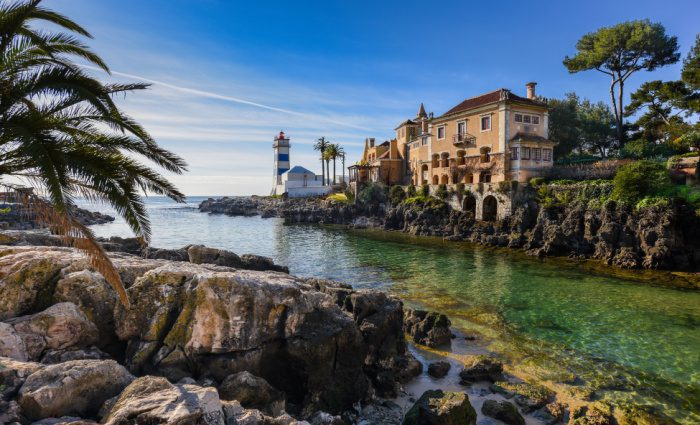
Just thirty minutes from Lisbon by train, and you’ll find yourself on the Portuguese Riviera, beautiful Cascais. Grand mansions mingle with fishermen’s cottages along this stretch of stunning coastline. The beaches get incredibly busy during the summer months, but there’s a little something for everyone. Sun, sea, and sand for the beach-lover, and a fantastic museum quarter with fascinating house museums and a wonderful gallery dedicated to the Portuguese artist Paula Rego.
Check out our article on Where to Stay in Cascais
24. See the Roman Ruins of Évora
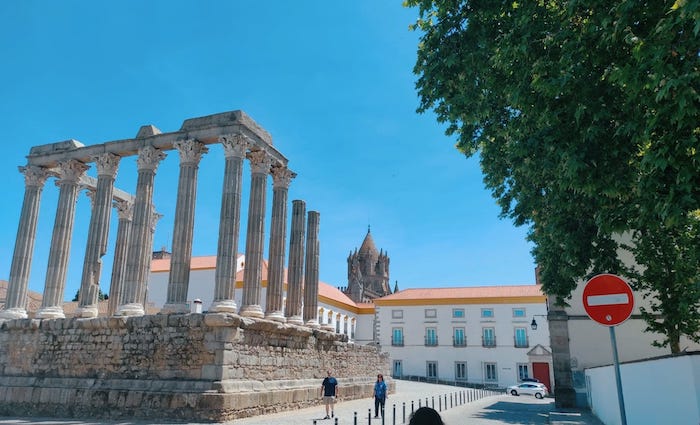
An hour and a half drive from Lisbon, Évora is one of Portugal’s gems. With its Roman temple, whitewashed walls, terracotta rooftops, and medieval layout make it one of the most picturesque towns in the country. Add to that excellent Alentejan wines and delicious food, and it is easy to see why Évora has been growing as a popular destination year after year.
25. Watch Record Breakers in Nazaré
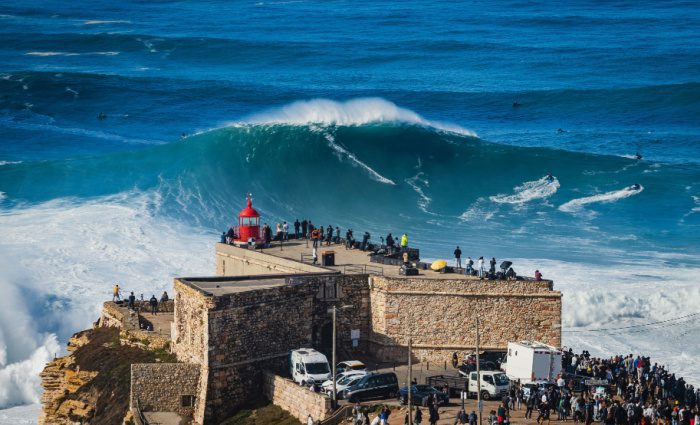
Nazaré is an hour and a half North of Lisbon. You’ll hear it described as a picturesque fishing town. That’s true, but it isn’t why most people come here. Of the ten highest waves ever surfed, seven have been in Nazaré. With the popularity of the HBO documentary “100 ft Wave” recounting the hunt for the first surfable 100-foot wave, Nazaré has become a beacon for extreme sports enthusiasts and curious tourists alike.
The town is beautiful and crowded during summer, but if you want to see the big wave season, then October through February is the best time of year to visit. I’d also tie it in with a visit with Óbidos, Fátima, or Tomar.
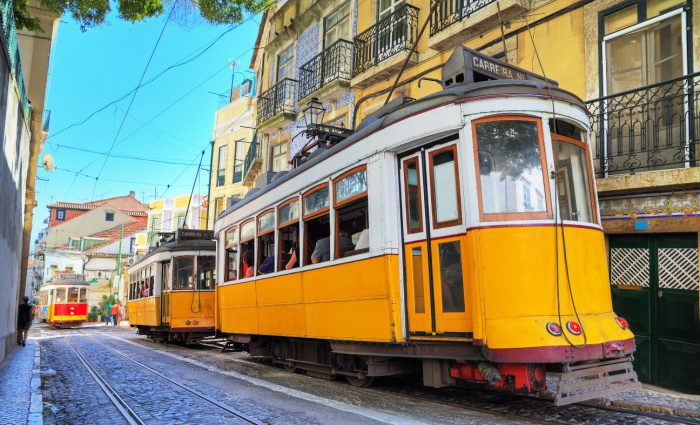
Where To Stay in Lisbon
One of Europe’s hottest destinations. Find our guide to the best places to stay in Lisbon!
